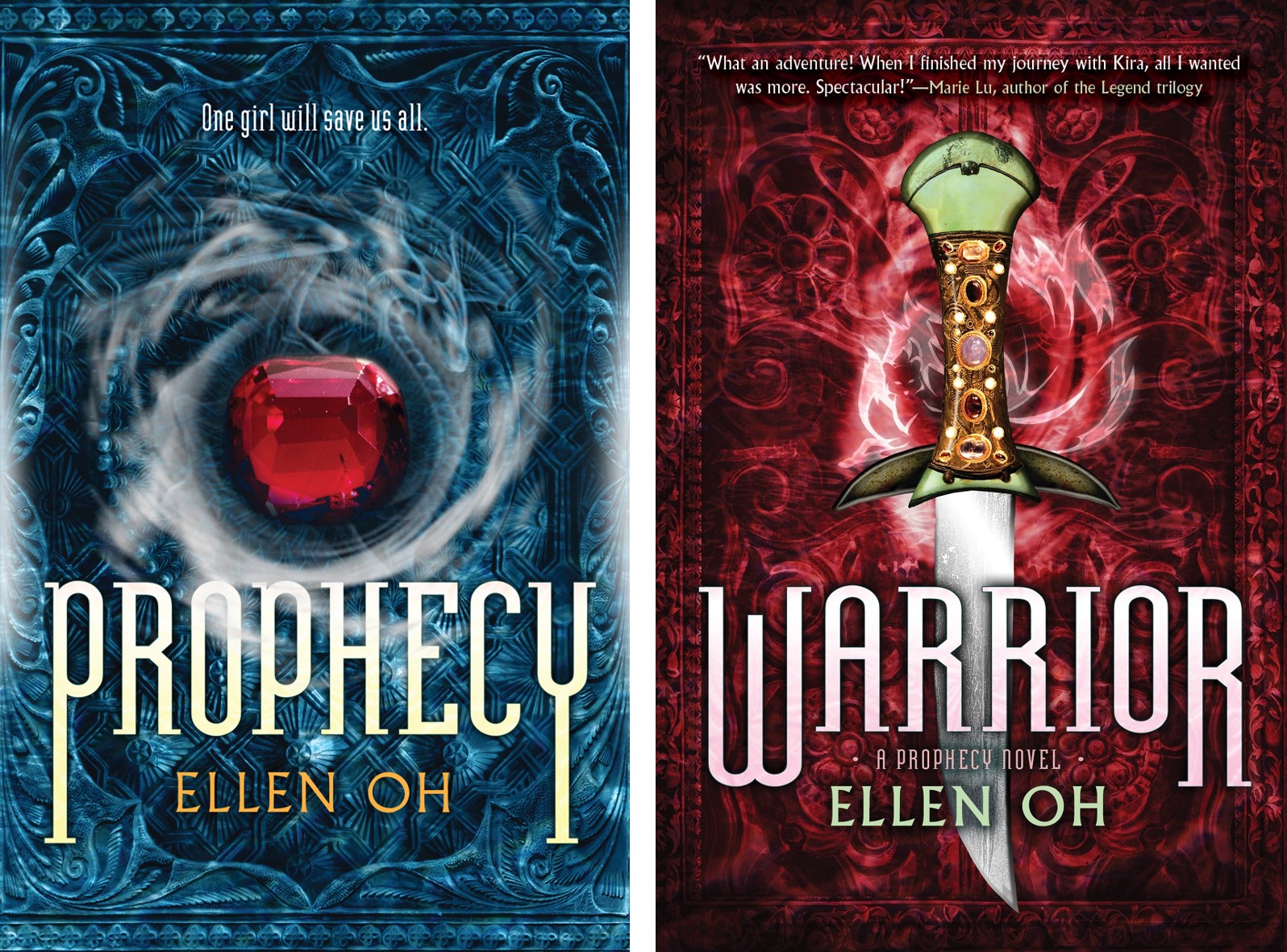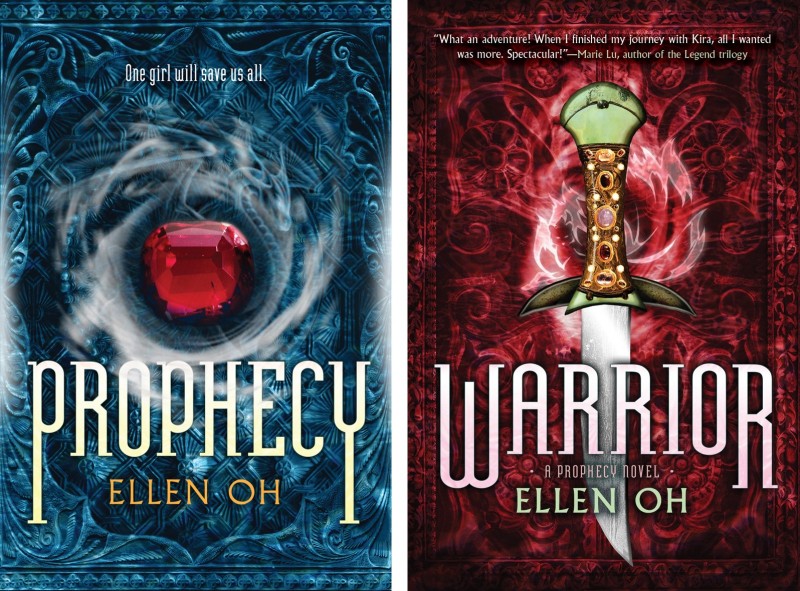08 Sep / Prophecy and Warrior by Ellen Oh + Author Profile [in Bloom]

 Ellen Oh’s Prophecy Trilogy and Why #WeNeedDiverseBooks
Ellen Oh’s Prophecy Trilogy and Why #WeNeedDiverseBooks
For Ellen Oh, good things seem to happen in threes. She’s the proud mother of three daughters. She’s had three careers – lawyer, professor, and finally a published writer (after 40!). The third book she wrote got her a three-book deal and put her in bookstores and library shelves around the world. That trilogy is Prophecy, of which the third volume pubs this December. Kira, her third-century Korean supergirl hero, is the youngest of three siblings, and she will spend three books seeking three treasures.
Beyond the page, Oh is the founding president of #WeNeedDiverseBooks, which officially took off with a three-day social media event and morphed into such a stupendously successful campaign that it’s literally, colorfully changing the face(s) of the publishing industry!
Given my recovering Catholic background, dare I say . . . Ellen Oh is practically holy.
The daughter of Korean immigrants, Oh grew up in Brooklyn and went to college at NYU. She then did the dutiful Asian American daughter thing and chose law school, heading south to Georgetown University. Legally degreed, she stayed in the DC area for love. Then came corporate law, and next entertainment law, which Oh insists isn’t quite as glamorous as it might sound. “It’s just contract law for television shows and movies. You don’t even get to meet anyone famous,” she writes in her blog bio. She did at one point see her name writ large on an IMAX screen with the ending credits, but she downplays that with “Not so impressive when your last name is HA.” That name thing is an open challenge: “My maiden name is Ha. I am now an Oh. I dare you not to laugh.”
Not until motherhood happened thrice did she finally begin to write in earnest. In spite of serious encouragement from a high school English teacher, putting actual pen to “random pieces of paper and Post-It notes” didn’t happen until decades later when she couldn’t find any books with the sort of strong Korean American characters she wanted her young daughters to be able to read. Girl power was paramount, and she found a few favorites here and there: The Hunger Games trilogy by Suzanne Collins, The Girl of Fire and Thorns trilogy by Rae Carson, The Hero and the Crown and The Blue Sword by Robin McKinley, and maybe a few others – but diversity on the page seemed too tall an order. So, of course, she channeled her inner Brooklyn Girl fighting spirit – I’m not even slightly exaggerating about the fighting! – and eventually wrote her own.
Prophecy is both the name of Oh’s young adult trilogy, and the title of the first in the series, which debuted in January 2013. “People feared Kira,” the heart-thumping novel begins. With her yellow eyes and unprecedented fighting skills, Kira is hardly the average teenager, much less the picture of modesty and subservience befitting a court royal. Her uncle the King considers her a “freak of nature, and a terrible embarrassment to the royal family,” and yet he must rely on her superior warrior strength to protect his only son and royal heir. Set in a fantasy version of ancient Korea, demons, imps, hobgoblins, and shamans threaten the entire peninsula, as the seven kingdoms fall one by one. In Kira’s home kingdom of Hansong, evil forces are moving through the ranks, possessing even once-trusted officials. The horrific events that the great ancestor, the Dragon King, prophesied are proving true: “Seven will become three. Three will become one. One will save us all.”
With the first of the three treasures in hand as the second book, Warrior (December 2013), opens, Kira has two more she must seek in order to fulfill the Dragon King’s prophecy. Most importantly, she must keep her young cousin-heir alive, a challenge that is growing ever more difficult as legions of half-demons attempt to murder their way into controlling her severely weakened, beloved home kingdom. Kira’s impossible mission is to reach a remote mountain where the second treasure is rumored to be buried, bringing her that much closer to fulfilling the prophecy. To get her there, her motley band of believers and protectors grow to include a goblin army made of her own blood. The legendary nine-tailed fox may or may not be an ally, but the vixen is certainly a distraction among the human soldiers. At 17, Kira is experiencing a tidal wave of new emotions, caught between her former against-her-will betrothed who seems to have returned from the dead transformed, and a gentle new friend haunted by a tragic past.
The showdown for Kira’s heart – not to mention the future of the entire world! – will be epic when the finale, King, hits shelves in just three months.
While Oh waits for her next pub date (as the industry goes, going from manuscript to bound object in a bookstore is an exercise in saintly patience), Oh has hardly been resting on her fantastic laurels. While her three-book deal with a major publisher was a stupendous personal feat, Oh recognized that her frustration over the lack of diversity in literature was building some serious momentum.
The numbers don’t lie: in June 2013, indie publisher Lee & Low Books released this disturbing graphic, showing “37% of the U.S. population are people of color” and yet “10% of children’s books in the last 18 years contain multicultural content.” In July of 2013, Katherine Hornig, director of the all-important CCBC: Cooperative Children’s Book Center which supplied the stats for Lee & Low’s chart, did a statistical breakdown of the first half of 2013 titles: the “big picture” showed that of the 1509 books received by the CBCC, 10.48% feature people of color. “It still looks like we are on track for yet another year of stagnation,” Hornig reported.
The full year’s CBCC final numbers prompted mega-award-winning, bestselling author Walter Dean Myers to reignite the diversity dialogue in March 2014 in the New York Times, just months before his death, with his column, “Where Are the People of Color in Children’s Books?” His son, acclaimed illustrator Christopher Myers, had a harsher battle cry in the same NYT issue with “The Apartheid of Children’s Literature.” One month later, BEA’s annual BookCon announced their line-up for kiddie lit, leaking the names of four white male authors. Eventually, the four headliners would lead a cast of 30 (white) authors. Grumpy Cat was added to the panel for . . . diversity? The message was clear: a disgruntled feline was more important than any writers of color. [click here for more …]
Author profile: “Ellen Oh’s Prophecy Trilogy and Why #WeNeedDiverseBooks,” Bloom, September 8, 2014
Readers: Middle Grade, Young Adult
Published: 2013
